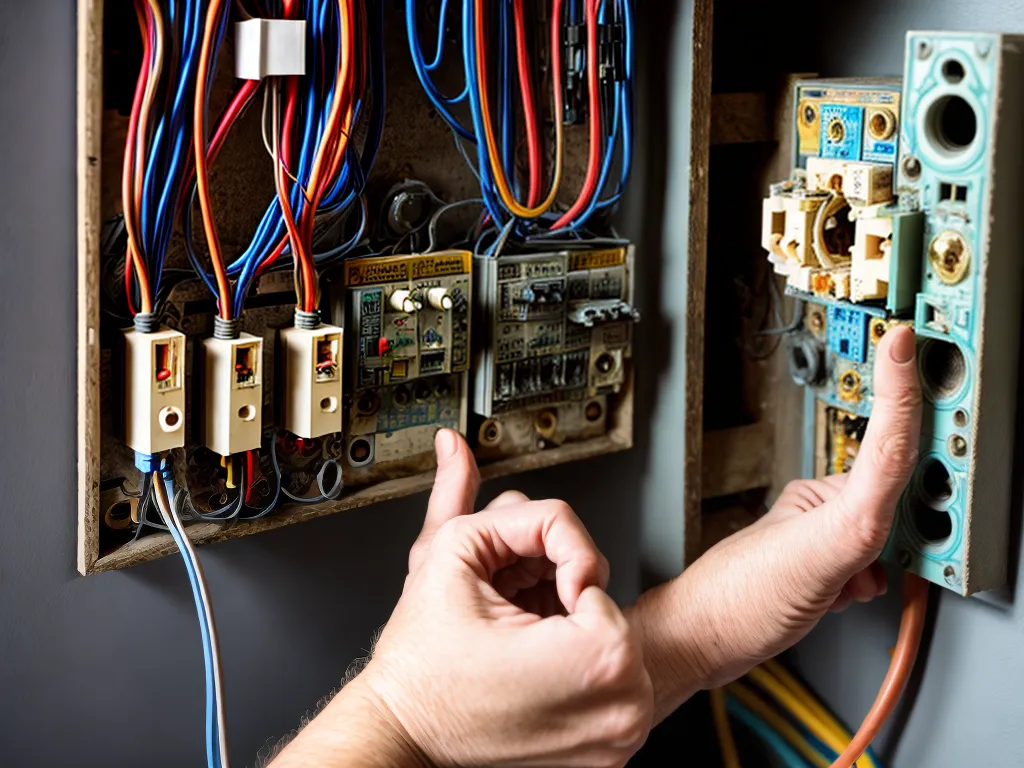
Living in an old house comes with charm and character, but also unique challenges when it comes to outdated electrical systems. As a homeowner of a historic property built before 1960, I have likely encountered knob-and-tube wiring, an early form of electrical wiring that can be problematic and even dangerous by today's standards. In this article, I'll provide a guide on identifying, evaluating, and troubleshooting knob-and-tube wiring to help maintain the safety and functionality of your vintage home's electrical system.
What is Knob-and-Tube Wiring?
Knob-and-tube (K&T) wiring was commonly installed in American homes built between 1880 and the 1940s. It consists of insulated copper conductors passing through ceramic knobs mounted to framing and spaced by porcelain tubes.
Unlike modern wiring systems which run wires through protective conduits, K&T wiring is exposed and often runs across floor joists and stud cavities. While this was an improvement over previous "open wiring" systems, the exposure leaves K&T vulnerable to damage.
Dangers and Downsides of Obsolete Knob-and-Tube Wiring
There are several drawbacks to having old K&T electrical wiring in your home:
-
Fire hazard - Exposed wires resting against wood and insulation can overheat or arc, increasing fire risk. K&T lacks grounded wires which are essential for safety.
-
Insufficient for modern loads - K&T was designed for simpler electrical needs. Today's larger appliances and electronics can overload the system.
-
Unsafe modifications - Homeowners sometimes modify K&T in unsafe ways by splicing more modern wires. This is extremely dangerous.
-
Difficult to repair - Ceramic knobs and tubes are obsolete, making repairs extremely challenging. Rerouting is often needed.
-
Insurance issues - Many insurers won't issue policies for homes with K&T or charge significantly higher premiums.
-
Lower property value - K&T wiring is viewed as unsafe and can decrease your home's value significantly.
How to Identify Knob-and-Tube Wiring
The first step is confirming if your home actually has knob-and-tube wiring. There are a few clear indicators:
-
Ceramic knobs - Look for glazed porcelain knobs with wiring coming out, often where wiring changes direction.
-
Tubes - You may see black or wooden tubes the wires are threaded through.
-
Wiring path - K&T wires follow joists and studs in straight lines rather than branching out like modern wiring.
-
Junction boxes - K&T often has old fashioned junction boxes with exposed live parts.
-
Wiring insulation - K&T wires have braided cloth or rubber insulation rather than modern plastic.
I recommend having an electrician inspect if you suspect K&T wiring during any renovation or rewiring project. Thorough inspection is key.
Evaluating the Condition of Existing Knob-and-Tube Wiring
If your home does contain K&T wiring, the next step is thoroughly evaluating its current condition and functionality. Here are important factors electricians inspect:
-
Modifications - Were improper splices or taps added over time? This can be extremely hazardous.
-
Insulation contact - Are wires in direct contact with insulation which can cause overheating?
-
Connections - Do junction points show heat damage or loose/exposed connections?
-
Voltage drop - Does voltage significantly drop under load? This indicates undersized wiring.
-
Grounding - Is grounding totally absent? K&T systems should be retrofitted with GFCI outlets.
-
Breaker panel - Is the electrical panel overload or using antique glass fuses? This needs upgrading.
-
Wire deterioration - Look for cracked, brittle, or frayed wire insulation which exposes conductors.
I kept detailed notes during the inspection and had my electrician explain any issues or risks discovered with my system.
Recommendations for Addressing Knob-and-Tube Wiring Hazards
If your K&T wiring evaluation uncovers significant hazards or deficiencies, I'd strongly recommend the following:
Removing All Accessible Knob-and-Tube Wiring
For any K&T you can access without demolishing walls, removal is ideal for maximum safety. I hired an electrician to:
- Disconnect and remove all visible K&T wiring.
- Install new wiring meeting modern code.
- Add new junction boxes and receptacles.
Total K&T removal provides peace of mind and may be required by insurers.
Addressing Inaccessible Wiring
For K&T inside walls, attics, and other closed spaces:
- Use thermal imaging to check for hot spots during load testing.
- Consider installing arc-fault detectors which can sense dangerous arcs in wires.
- Have an electrician confirm wires are not overloaded by circuit.
It's impractical to remove all enclosed K&T, so take precautions to reduce fire risk.
Upgrading Electrical Panel and Components
Finally, upgrade your electrical service panel, bus bars, main disconnect, and breakers to meet modern home electrical requirements. Installing new surge protective devices and lightning arrestors is also wise to protect your delicate K&T wiring from surges.
I took a phased approach to upgrades spread over time to minimize disruption and cost. Safety was the priority.
Maintaining Vintage Wiring in a Historic Home
While obsolete knob-and-tube wiring requires vigilance and occasional upgrades, don't let it deter you from purchasing a charming historic home. With proper inspections, modifications, and maintenance, K&T wiring can be kept safe and functional for decades to come. Prized historic homes are worth the extra effort.
I'm happy to retain the original K&T wiring running through the walls of my 1920s arts and crafts style home. The visibility of the porcelain knobs and black tubes reminds me of the fascinating history of electrical wiring technology over the past 140 years. With the right precautions, you can safely preserve a piece of the past while enjoying all the comforts of the present.